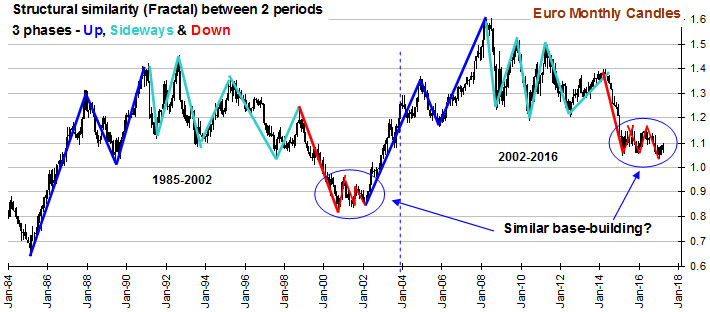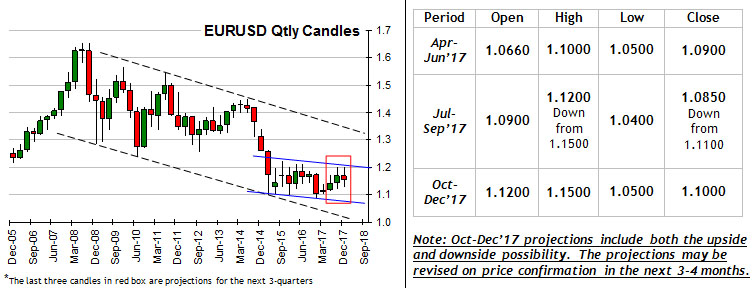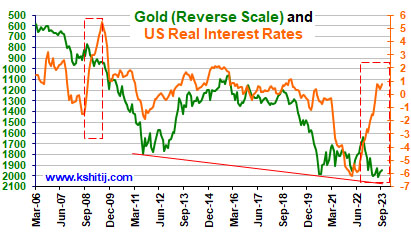Euro Long term Forecast – May’17
May, 09, 2017 By Vikram Murarka 0 comments

9-May-17 / Euro 1.0907
EXECUTIVE SUMMARY:
Recap: In our April’17 report, we expected Euro to be stable in the range of 1.05-1.10 for a couple of months followed by an expansion of the range with equal chances of a breakout on either side.
There is no change in view as Euro tested but failed to break above the major resistance of 1.10. A break above 1.10 is a necessary condition for further rise to 1.12 and 1.15 but the downside risk remains open till the breakout is seen.
The chart above shows the structural similarity between two different phases of Euro. It definitely looks like Euro is repeating the structure seen in 1985-2002 since the rally of 2002. In both the cases, the bull market took place in 3 legs (marked by blue lines), sideways consolidation in 6 legs (marked by indigo lines) and a bear market starting with a sharp decline (red lines). Will the current sideways consolidation really turn out to be mirroring the consolidation seen in 2000-02? We don’t know yet but the probability can’t be discarded keeping in mind the overwhelming similarity in its entirety. If the similarity continues, then we can expect a new bull market starting, probably in 2018.
Volatility compression
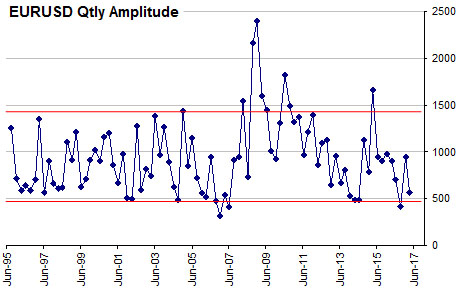 The chart on the left shows the quarterly amplitude of Euro or in other words, how much it has moved in a quarter, placed on the time axis to catch any emerging pattern.
The chart on the left shows the quarterly amplitude of Euro or in other words, how much it has moved in a quarter, placed on the time axis to catch any emerging pattern.
We can see the amplitude primarily oscillating around 1000 pips but in the last quarter, the movement has been limited in a much narrower range of 567 pips.
With the broader range defined by 500 to 1500 pips for the last 20 years, an expansion of the amplitude can be expected in the current quarter, implying a sharp directional move.
With 60% of the current quarter still left, the current quarter amplitude stands at 432 pips which look unsustainable. That means, either the current quarter low of 1.0568 or the high of 1.1000 must give way. We have no directional bias inside 1.05-1.10 as discussed previously and prefer to wait and watch.
Correlation between Euro and Swiss
 |
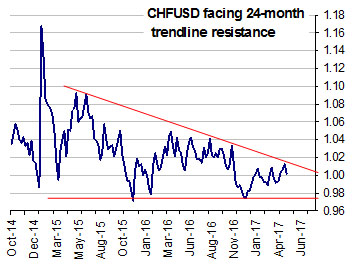 |
The chart on the left side shows the strong correlation between Euro and Swiss (USDCHF inverted). Swiss was pegged to Euro in the period of 2011-2014 but despite the peg broken in Jan’15, Swiss continues to mirror Euro. As the right chart shows, Swiss (USDCHF inverted) has strong resistance near 1.02-1.03 and an immediate break above 1.02-03 looks difficult, which may cap the near term upside for Euro to 1.10.
Quarterly Projections
Conclusion
Euro could be stuck within the broad 1.10-1.05 region in the coming months with no strong directional clue visible. Any failure to rise from either 1.10 may push it down towards 1.07-1.06 but the downside may be limited to 1.04 for the current year.
Array
You may also like:
Aussie Long term Forecast – Jun’17
10, Jun 2017
Euro Long term Forecast – Jun’17
9, Jun 2017
Japanese Yen Long term Forecast – Jun’17
13, Jun 2017
Aussie Long term Forecast – Jul’17
8, Jul 2017
Japanese Yen Long term Forecast – Jul’17
8, Jul 2017
Euro Long term Forecast – Jul’17
8, Jul 2017
Aussie Long term Forecast – Aug’17
5, Aug 2017
Euro Long term Forecast – Aug’17
5, Aug 2017
Japanese Yen Long term Forecast – Aug’17
5, Aug 2017
Euro Long term Forecast – Sep’17
7, Sep 2017
Japanese Yen Long term Forecast – Sep’17
13, Sep 2017
Japanese Yen Long term Forecast – Jan’18
19, Jan 2018
Since 2006, generally a rising Real Yield is accompanied by falling Gold and falling Real Yield by rising Gold, except for the periods marked in the two broken red boxes. In these two times we see Gold rising despite a sharp increase in the Real Yields. …. Read More
Brent has risen sharply contrary to our expectation of seeing a fall from $90. Will it sustain trade above $90? … Read More
News from the ECB on hinting at possible pause in rate hikes earlier in July and then in September along with a higher US NFP data in early Sep-23 has aided Euro to fall and remain below 1.08 ……. Read More
Our October’23 Quarterly Dollar-Rupee Forecast is now available. To order a PAID copy, please click here and take a trial of our service.
Our October’23 Quarterly Dollar-Rupee Forecast is now available. To order a PAID copy, please click here and take a trial of our service.
- Kshitij Consultancy Services
- Email: info@kshitij.com
- Ph: 00-91-33-24892010
- Mobile: +91 9073942877

